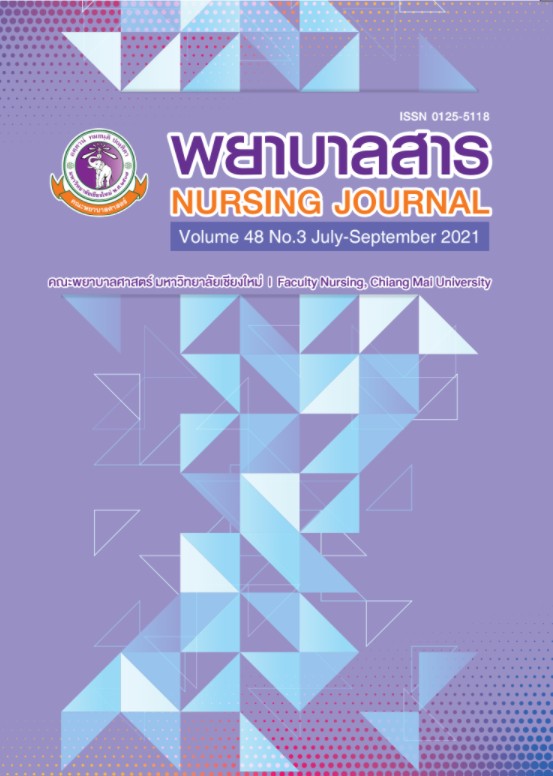Physical and Psychosocial Work Characteristics and Musculoskeletal Discomfort Among Workers in Electronics Factory
Keywords:
Physical work characteristics, Psychosocial work characteristics, Musculoskeletal discomforts, Electronic workersAbstract
Work-related musculoskeletal discomfort is a significant occupational health problem for workers in an electronics factory. This is a correlational descriptive study of physical work characteristics, psychosocial work characteristics and musculoskeletal discomforts among 378 workers in an electronics factory. The study instrument was self-administrative and consisted of four parts: 1) personal and working information, 2) physical work characteristics, 3) psychosocial work characteristics, and 4) musculoskeletal discomforts. The study instrument was reviewed by experts and gained the content validity index of 1.0. Three parts of the instrument: physical work characteristics, psychosocial work characteristics, and musculoskeletal discomforts, were tested for reliability and yielded acceptable values of 0.93, 0.84 and 0.86, respectively. Data were analyzed using descriptive statistics, chi-square test and biserial correlation coefficient.
The results showed that he relationship between physical work characteristics and musculoskeletal discomforts was statistically related (x2=12.85, 4.66, p < .05). Regarding to psychosocial characteristics, the job demands was statistically significant related to musculoskeletal discomforts prior to seven days and twelve months of the study (r = 0.12 and 0.15 at p < .05, respectively).
These results suggest that physical and psychosocial work characteristics are important factors associated to musculoskeletal discomforts in workers in an electronics factory. These two types of working characteristics should be improved upon in order to enhance these workers’ health.
References
Chaikan, W., Chanprasit, C., & Kaewthummanukul, T. (2007). Ergonomic factors and prevalence rate of musculoskeletal pain among workers in semiconductor factory industry in the Northern Region Estate. Journal of Health Science, 16, 226-233. (in Thai)
Chaiklieng, S., Pannak, A., & Duangprom, N. (2016). The assessment of ergonomic risk on upper limp disorders among electronic workers. Srinagarind Medical Journal, 31(2), 202-209. (in Thai)
Chee, H. L., Rampal, K. G., & Chandrasakaran, A. (2004). Ergonomic risk factors of work processes in the semiconductor industry in Peninsular Malaysia. Industrial Health, 42(3), 373-381.
Christensen, J. O., & Knardahl, S. (2010). Work and neck pain: A prospective study of psychological, social, and mechanical risk factors. Pain, 151(1), 162-173. doi:10.1016/j. Pain.2010.07.001
Department of Disease Control, Ministry of Public Health. (2015). Annual report, 2015. (in Thai) Retrieved from http://www.thaincd.com/document/file/download/paper-manual/Annual-report-2015. pdf.
International Ergonomics Association (IEA). (2010). What is ergonomics? Retrieved from https://iea.cc/what-is-ergonomics/
Jaiban, P, Suthakorn, W., & Kaewthummanukul, T. (2013). Ergonomic factors and work-related musculoskeletal disorders among hospital supporting staffs working with computers. Nursing Journal, 40 (supplement), 1-11.
Jirachewee, J. (2006). Prevalence and factors affecting job strain among workers in an electronic factory (Master’s thesis). Graduate School, Mahidol University, Thailand. (in Thai)
Johansson, G. (1991). Job demands and stress reactions in repetitive and uneventful monotony at work. In J. V. Johnson & G. Johansson (Eds.), The psychosocial work environment: Work organization, democratization and health (pp. 61-71). New York: Baywood.
Kang, S.-K., & Kim, E. A. (2010). Occupational diseases in Korea. Journal of Korean Medical Science, 25, S4-S12. doi:10.3346/jkms.2010.25.S.S4
Karasek, R. A., Brisson, C., Kawakami, N., Houtman, I., Bongers, P., & Amick, B. (1998). The job content questionnaire: An instrument for internationally comparative assessments of psychosocial job characteristics. Journal of Occupational Health Psychology, 3(4), 322-355.
Larsman, P., & Hanse, J. J. (2009). The impact of decision latitude, psychological load and social support at work on the development of neck, shoulder and low back symptoms among female human service organization workers. International Journal of Industrial Ergonomics. (39), 442-446. doi:10.1016/j.ergon.2009.01.002
National Institute for Occupational Safety and Health (NIOSH). (2013). Providing national and world leadership to prevent workplace illnesses and injuries. Retrieved from http://www.cdc.gov/NIOSH/
Nieuwenhuijsen, K., Bruinvels, D., & Fring-Dresen, M. (2010). Psychosocial work environment and stress-related disorders, a systematic review. Occupational Medicine, 60(4), 277-286. doi:10.1093/0ccmed/kqq081
Park, J.K., & Jang, S.-H. (2010). Association between upper extremity musculoskeletal disorders and psychosocial factor at work: A review on the Job DCS Model’s perspective. Safety and Health at Work, 1(1), 37-42. doi:10.5491/SHAW.2010.1.1.37
Pullopaissakul, S. (2011). Prevalence and associated factors of upper extremities musculoskeletal diseases among workers in electric and electronic assembly factory (Master’s thesis in Occupational medicine). Graduate school, Srinakharinwirot University, Thailand. (in Thai)
Social Security Organization (SSO), Workmen Compensation, Ministry of labor. (2009). Workmen compensation annual report (2009). (in Thai) Retrieved from http://www.sso.go.th/wpr/uploads/ uploadImages/file/reporty2552.pdf
Spallek, M., Uibel., S., Mark, A., & Quarcoo, D. (2010). Work-related musculoskeletal disorders in the automotive industry due to repetitive work - implications for rehabilitation. Journal of Occupational Medicine and Toxicology. 5(6) Retrieved from http://www.occup-med.com/content/5/1/6
Widanarko, B., Legg, S., Stevenson, M., Devereux, J., Eng, A., Mannetje, A., Cheng, S., & Pearce, N. (2011). Prevalence and work-related risk factors for reduced activities and absenteeism due to low back symptoms. Applied Ergonomics, 43(4),727-37. doi:10.1016/j.apergo.2011 .11.004
Yu, W., Lao, X. Q., Pang, S., Zhou, J., Zhou, A., Zou, J., . . . Yu, I. T. (2013). A survey of occupational health hazard among 7,610 female workers in China’s electronics industry. Archives of Environment & Occupational Health, 68(4), 190-195. doi:10.1080/19338244. 2012.701244
Zakerian, S. A., & Subramaniam, I. D. (2009). The relationship between psychosocial work factors, work stress and computer-related musculoskeletal discomforts among computer users in Malaysia. International Journal of Occupational Safety and Ergonomics, 15(4), 425-434. doi:10.1080/10803548.2009.11076822
Downloads
Published
How to Cite
Issue
Section
License
บทความที่ได้รับการตีพิมพ์เป็นลิขสิทธิ์ของวารสารพยาบาลสาร
ข้อความที่ปรากฏในบทความแต่ละเรื่องในวารสารวิชาการเล่มนี้เป็นความคิดเห็นส่วนตัวของผู้เขียนแต่ละท่านไม่เกี่ยวข้องกับมหาวิทยาลัยเชียงใหม่ และคณาจารย์ท่านอื่นๆในมหาวิทยาลัยฯ แต่อย่างใด ความรับผิดชอบองค์ประกอบทั้งหมดของบทความแต่ละเรื่องเป็นของผู้เขียนแต่ละท่าน หากมีความผิดพลาดใด ๆ ผู้เขียนแต่ละท่านจะรับผิดชอบบทความของตนเองแต่ผู้เดียว






